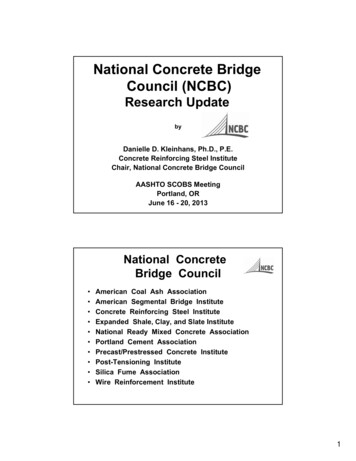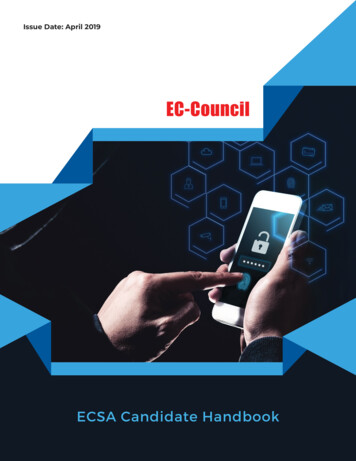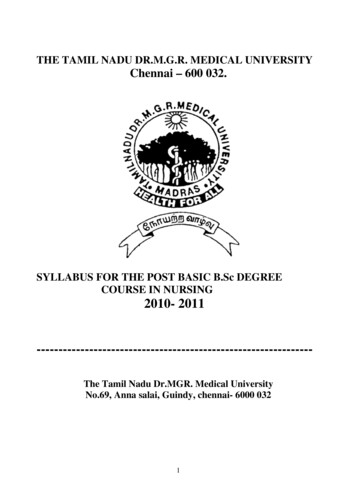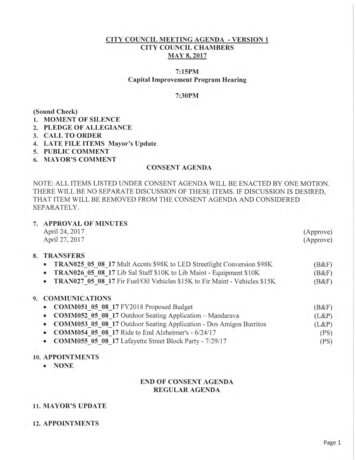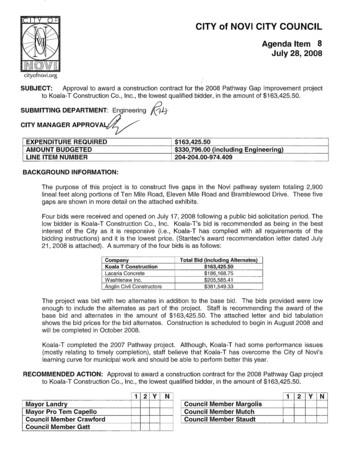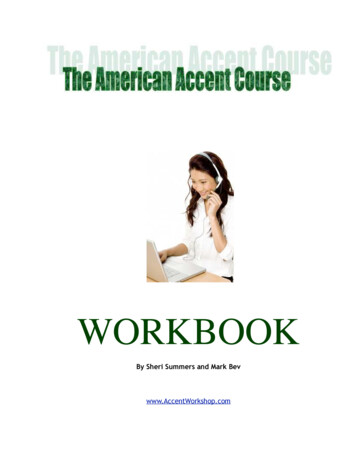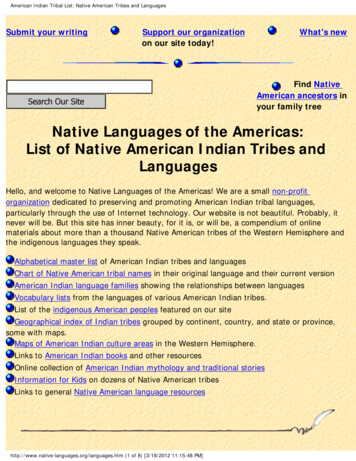
Transcription
AMERICAN COUNCIL ON THE TEACHING OF FOREIGN LANGUAGES(ACTFL)PROGRAM STANDARDSFOR THE PREPARATION OFFOREIGN LANGUAGE TEACHERS (2013)(INITIAL LEVEL—Undergraduate & Graduate)(For K-12 and Secondary Certification Programs)Prepared by the Foreign Language Teacher Preparation Standards Writing TeamSubmitted for Approval to the CAEP State Partnership and Content Areas Committee(Formerly the NCATE Specialty Area Studies Board)Council for Accreditation of Educator Preparation (CAEP)Submitted August 15, 2013Approved December 13, 2013For questions about these standards and/or the program review process, contact theAmerican Council on the Teaching of Foreign Languages (ACTFL)1001 North Fairfax Street, Suite 200Alexandria, VA 22314 Ph: 703-894-2900 ext. 110 Fx: (703) 894-2905Executive Director Marty Abbott (mabbott@actfl.org)SPA Coordinator Judith Shrum (caep@actfl.org)
2TABLE OF CONTENTSIntroductory material1. Title PageAcknowledgements2. Brief introduction to the program standards for SASB useBrief history of foreign language instruction3. Statement on development of the Standards for ProgramsPreparing Foreign Language TeachersHow the Revised Standards were developedThe knowledge base that supports the Standards basedon empirical research, disciplined inquiry,informed theory, and the wisdom of practice C.1.b.Using the Knowledge BaseReferences for Knowledge Base4. Potential duplication and/or overlap in standardsOutline of how these program standards are aligned withthe field’s student standards as well as the standardsdeveloped by the Interstate Teacher Assessmentand Support Consortium (InTASC) and the NationalBoard for Professional Teaching Standards (NBPTS)as adopted by the SASB5. Analysis of Differences from Current StandardsStandards6. Implementation of SASB Policy on GuidelinesDiversity, Technology & DispositionsProposals for Waivers (NA)7. Decisions on waivers (NA)8. The ACTFL/CAEP StandardsSupporting Material9. Information on conduct of SPA responsibilities underCAEP State Partnerships10. Training and Resources11. Information on SPA procedures for selection, training, andevaluation of program reviewers and representation ofdiversity within the profession12. Optional supplemental documentAttachment C13. List of Appendices14. Checklist2358919214150555761626263, 64969696979899100-110
3ACKNOWLEDGEMENTSJudith L. ShrumDave McAlpineEileen GlisanJune PhillipsRebecca FoxNathan BondMarty AbbottAnne NerenzDuarte SilvaMarjorie TussingVirginia Tech, EmeritaUniversity of Arkansas, Little RockIndiana University of PennsylvaniaWeber State University, EmeritaGeorge Mason UniversityTexas State UniversityACTFL Executive DirectorEastern Michigan UniversityStanford UniversityCalifornia State University, FullertonWe are grateful to the Foreign Language Standards Collaborative for supporting and fundingthe development of these standards.NOTE: The term “Standards,” in italics with upper case “S”, also abbreviated SFLL, refers to thedocument for student learning Standards for Foreign Language Learning in the 21st Century,also known by the familiar term “5Cs” (see Appendix A). The terms “ACTFL/CAEP Standards”and the term “Standards” with upper case “S” and no italics refer to the program standards forteacher preparation programs. In addition, the full title of the program standards documentappears in italics: ACTFL/CAEP Program Standards for the Preparation of Foreign LanguageTeachers.
42. INTRODUCTIONThe American Council on the Teaching of Foreign Languages (ACTFL) is submitting its revisedProgram Standards for the Preparation of Foreign Language Teachers—Initial Level to theSpecialty Areas Studies Board (SASB) of CAEP for approval. These standards were initiallyapproved in 2002 and this is the first revision of them. These standards apply only to the initiallevel of teacher preparation at all levels.Institutions seeking recognition of their foreign language teacher preparation programs submitfull program reports to CAEP/ACTFL, or submit reports for continuing recognition if they havebeen recognized since 2002.This section presents background information about the field of foreign language instructionand teacher preparation in terms of a brief history of foreign language instruction, concludingwith a description of the student Standards for Foreign Language Learning in the 21st Century(2006). This introduction will serve as the foundation for the proposed program standards thatfollow.A Brief History Of Foreign Language InstructionThe early history of modern foreign language instruction in the United States is characterized bythe prevalent attitude expressed formally by the Committee of Twelve in 1892 that speakingability was less important than “Humanism, linguistic erudition and literary culture” (Mackey,1965). The grammar-translation approach, employed for centuries for the instruction ofclassical languages, was simply applied, with few exceptions, as a model for modern languageinstruction from the late nineteenth century in the early 60s of the twentieth century. Thismodel was further reinforced in the findings of the Modern foreign Language Study whenColeman (1929) concluded that teaching of the spoken languages was “irrelevant” and“impractical” and that fluency in reading, command of the grammar, and the ability to translateliterature were major goals of foreign language study.The opportunity to change the course of language teaching and therefore, the training of preservice and in-service teachers came in 1958 with the introduction of the National DefenseEducation Act (NDEA), brought about by the Soviet launching of Sputnik. In order to meet theperceived needs of a nation whose scientific and political status was being challenged, theNDEA established intensive summer institutes where the participants developed speaking skills,learned current information about the cultures of target language speakers, and wereinstructed in the latest methodology and linguistics. Many institutes were eventually held in thetarget language countries. The NDEA supported the establishment and expansion of languageprograms in the less-commonly taught languages of the world through foreign language areacenters and graduate fellowships. The NDEA also gave legitimacy to learning a language in theK-12 school curriculum (Clowse, 1981). Although still targeted at the better students, schoolsmade language study available to more students and in longer sequences. Along with these
5changes came a new way to teach languages: the audio-lingual approach (ALM). Based onbehaviorist principles, teachers used pattern drills to help students learn the spoken languagethrough the mimicking and memorizing of dialogues presented in textbooks, often with nativespeakers on tapes. Teacher-directed methodologies remained prevalent throughout the 1970sand 1980s.Beginning in the 1980s, there was a growing awareness that behaviorist strategies inherent inthe ALM were ineffective in producing speakers with functional language ability. Teachers inthe field and researchers in second language acquisition took a new look at aspects of languagein order to define communicative competence, demands also came from real-worldapplications for language that included sending Americans abroad to work with people in awide variety of settings in a multitude of countries. The need to prepare these people as well asto assess their language competency called for functional assessment measures and a commonyardstick that could be applied reliably in educational as well as non-education settings. Thisnecessitated a focus based on communicative approaches and even greater attention to theindividual learners, the learning environment, and learner strategies. The result was publicationin 1986 of the American Council on the Teaching of Foreign Languages/Interagency Roundtable(ACTFL/ILR) Proficiency Guidelines. These guidelines shifted the emphasis in languageinstruction from what learners knew about the language to what they could do with thelanguage they were learning, and at the same time, established a “common metric” fordescribing students performance in listening, speaking, reading, and writing at the Novice,Intermediate, Advanced, and Superior levels.Learner standards K-16 appeared with the publication of Standards for Foreign LanguageLearning in the 21st Century (1999, 2006), developed by a collaborative of nine foreign languageassociations that comprised the National Standards in Foreign Language Educationcollaborative Project, representing close to 40,000 foreign language educators: the AmericanAssociation of Teachers of French (AATF), American Association of Teachers of German (AATG),American Association of Teachers of Italian (AATI), American Association of Teachers of Spanishand Portuguese (AATSP), the American Classical League (CLA), the American Council on theTeaching Foreign Languages (ACTFL), the American Council on the Teacher of Russian (ACTR);the Chinese Language Association of Secondary-Elementary Schools (CLAS), the ChineseLanguage Teachers Association (CLTA), and the National Council of Japanese Language teachers(NCJLT), and the Association of Teachers of Japanese (ATJ). The establishment of such a workingcollaborative and its active involvement in the development of the document represent astrong unified movement in the field. The Executive Council of the Modern LanguageAssociation (MLA) has also endorsed the standards.Today, in 2012, more than 45 professional language associations support the standards. Foreignlanguage study is attracting a much broader audience than in the past when a primary goal ofmany programs was nothing more than to reproduce those who were already teachinglanguages. Rather, the “Statement of Philosophy” in the Standards seeks to embrace foreignlanguages for all students. Language study is no longer only for the elite, college-boundstudents: “Language and communication are at the heart of the human experience. The United
6States must educate students who are equipped linguistically and culturally to communicate ina pluralistic American society and abroad. This imperative envisions a future in which ALL(Emphases in original) students develop and maintain proficiency in English and at least oneother language, modern or classical (National Standards in Foreign Language Project, 1999, p.7).The K-16 standards feature a description of what students should know and be able to do withan emphasis on learning content while acquiring language, and demonstrating what they knowthrough their performance. Moving from the previous focus on language and culture to one oncommunication and culture, the standards are organized around the following five goals oflanguage learning by students:1. Communication: Communicate in Language Other than EnglishCommunication is characterized by three “communicative modes” that place primary emphasison the context and purpose of the communication: The interpersonal mode is characterized by two-way communication and activenegotiation of meaning among individuals in written or spoken form. The interpretive mode focuses on the understanding and interpretation of oral andprinted text, in which no active negotiation of meaning is possible. The presentational mode refers to the oral and written presentation of information,concepts, and ideas to an audience of listeners or readers.2. Cultures: Gain knowledge and Understanding of Other CulturesWoven inextricably into language is the “world view” of those who live in a culture. Thisanthropological view of culture features three interrelated components. Perspectives: meanings, attitudes, values, ideas; Practices: pattern of social interactions; and Products: books tools, foods, laws, music and games.3. Connections: Develop Insight in the Nature of Language and CultureMaking connections to other disciplines expands the educational experiences of all studentsbeyond the traditional “canon,” allowing them to acquire information through the secondlanguage by means of content-based learning experiences at all levels of instruction.4. Comparisons: Develop Insight into the Nature of Language and CultureStudents benefit from language learning by discovering different patterns among languagesystems and cultures and gaining insights into both the target and native languages andcultures.5. Communities: Participate in Multilingual Communities at Home and Around the WorldKnowledge of other languages and cultures not only enables students to acquire job skills inmultilingual communities but also encourages them to develop a life-long interest in language
7and cultures for personal enjoyment and personal enrichment.3. STATEMENT ON DEVELOPMENT OF STANDARDS FOR PROGRAMSPREPARING FOREIGN LANGUAGE TEACHERSThe lead organization in the Collaborative Project to develop standards is the American Councilon the Teaching of foreign Languages (ACTFL), a national organization for the foreign languageteaching profession established in 1967 by the leadership of the MLA to address issuesregarding teacher education, language instruction, and curriculum development. ACTFL is theonly national organization dedicated to the improvement and experience of the teaching andlearning of all languages at all levels of instruction. It is an individual membership organizationof more the 10,000 foreign language educators and administrators from elementary throughgraduate education, as well as government and industry. ACTFL publishes the journal ForeignLanguage Annals, the magazine The Language Educator six times per year, a variety ofresources geared toward understanding language proficiency levels and assessing studentlanguage performance, and makes available critical resources for methods instructors, firsttime teachers, job seekers and more. It sponsors an annual conference and providesprofessional development workshops and seminars for its membership on topics such as oralproficiency testing, standards-based instruction, authentic assessment, and second languageacquisition research. ACTFL works closely with language associations in all 50 states. Among themembers of its Executive Council are representatives of the five regional foreign languageconferences: the Northeast Conference on the Teaching of Foreign Languages (NECTFL), theSouthern Conference on Language Teaching (SCOLT), the Central States Conference on theTeaching of Foreign Languages (CSCTFL), the Southwest Conference of Language Teaching(SWCOLT), and the Pacific Northwest Council for Foreign Languages (PNCFL). The ACTFLdelegate Assembly, held during is annual conference, includes representatives from all 50states, the regional organization, the language specific organizations listed above, as well asother language organizations.In consonance with its mission to serve teacher education, ACTFL developed provisionalProgram Guidelines for Foreign Language Teacher Education in 1988, which have been used byteacher-preparation institutions as they develop and revise their programs. ACTFL became amember organization of NCATE in 1998, with the support and active involvement of theCollaborative project (see Appendix A).Now, at the beginning of the twenty-first century, a number of important standards-relatedinitiatives make up our professional agenda. The K-16 student standards have stronglyinfluenced the development of standards for (1) the national recognition of initial programs ofteacher preparation through the Council for Accreditation of Educator Preparation (CAEP), (2)initial teacher licensure through the Interstate Teacher Assessment and Support Consortium(InTASC), and (3) recognition of accomplished foreign language teachers through the NationalBoard for Professional Teaching Standards (NBPTS). The relationship of the ACTFL/CAEPProgram Standards with these initiatives will be discussed later, beginning on p. 50.
8These revised 2014 ACTFL/CAEP Program Standards for the Preparation of Foreign LanguageTeachers are critical to our professional agenda because they provide a “viable framework forindentifying the components of effective and innovative foreign language teacher preparationprograms, presenting current programs that exemplify those components, and continuing tofurther define features of model teacher preparation.” (Huhn, 2012, p. S163)How the Revised Standards 2014 were developedAt its Fall 2009 session, the ACTFL Audit Team nominated leaders in the field of foreignlanguage education to serve with Audit Team members on a Standards Writing Team fordevelopment of Revised Standards. The Writing Team members are listed below:Dave McAlpine (Co-Chair)Judith L. Shrum (Co-Chair)Eileen GlisanJune PhillipsRebecca FoxNathan BondMarty AbbottAnne NerenzDuarte SilvaMarjorie TussingUniversity of Arkansas, Little RockVirginia Tech, EmeritaIndiana University of PennsylvaniaWeber State University, EmeritaGeorge Mason UniversityTexas State UniversityACTFLEastern Michigan UniversityStanford UniversityCalifornia State University, FullertonThis group, co-chaired by Dave McAlpine and Judith Shrum, met for two days in January 2010 atACTFL headquarters in Alexandria VA to examine the 2002 Standards and revised themaccording to the four Principles established by NCATE/CAEP at that time: Content Knowledge,Content Pedagogy, Learning Environments, Professional Knowledge and Skills. The revisedStandards were then aligned with the NCATE/CAEP/InTASC principles (2011): The Learner andLearning, Content, Instructional Practice, and Professional Responsibility. In addition, weexamined ACTFL dispositions and determined that all dispositions and technology expectationscould be examined at the Unit level, and that wording regarding dispositions and technologycould be incorporated into expectations within the rubrics for the SPA standards. Weincorporated in each rubric performances that reflected the importance of diversity andtechnology. Eileen Glisan contributed the initial drafts of the Knowledge Base and circulated itto the Writing Team for comments. A draft version of the Standards document was circulatedand edited by the Audit Team members in January 2012, again in January 2013, and finally inJune 2013.We sought consensus among the members of the profession with four efforts. First, themembers of the revised Standards Writing Team were selected specifically for theirrepresentation of various language groups and geographic regions of the US. Three membersrepresented French, one represented German, one Latin, four Spanish, and one
9French/Spanish. Geographically, two were from the western US, three from the Midwest, threefrom the eastern US, and two from the national capital region.In our second effort to seek consensus, members of the Task Force presented a draft of therevised Standards at five regional conferences: Central States Conference on the Teaching ofForeign Languages (CSCTFL), Southern Conference on the Teaching Foreign Languages (SCOLT),Southwest Conference on the Teaching of Foreign Languages (SWCOLT), Northeast Conferenceon the Teaching of Foreign Languages (NECTFL), and at the Pacific Northwest Conference forForeign Languages (PNCFL).Our third approach to seek consensus was an online survey available between April 28 and June22, 2012 in which we sought feedback and solicited targeted and open-ended comments on thedraft of the revised Standards. We encouraged a wide range of professionals in the field torespond to the survey. An analysis of the data and the comments is reported below.Our fourth effort to seek consensus was to present the standards and highlights of the surveyresults to the profession at our national convention in November 2012. The standards shown atthat time reflected the comments and changes resulting from the survey. Feedback gathered atthe national convention was shared with the Writing Team.Our fifth approach was to solicit input from the public at large and from NCATE stakeholders ina second survey available between April 15 and June 1, 2013. This survey reflectedmodifications in the standards that resulted from previous surveys and face-to-face input fromthe profession as well as input from the SASB on our “one year out” report in November 2012.The discussion below highlights the survey of the profession since the number of responses waslarger. The second survey, for the public at large and NCATE stakeholders, results follow but arediscussed only briefly.First Survey (for the Profession)Three hundred ninety three people responded to the survey, representing these groups.Professional RoleForeign language professorEducation professorCollege AdministratorState ConsultantForeign Language Association officerK-12 Foreign language teacherForeign language/Education majorK-12 AdministratorTotal responsesN of responses14851159242003643526% of responses28103253878100*
10*Rounding errorRespondents were asked to check no more than two of the above categories, since manyprofessionals in foreign language education perform multiple roles. More than 38% of theresponses came from K-12 foreign language teachers and the next largest group was foreignlanguage professors in higher education with 28% of the responses. The number of years ofexperience most represented was 30 , followed by 16-20. We view this as a solid response,with good participation by foreign language professors and K-12 foreign language teachers whoform the two constituent groups that use and are most affected by the Standards.The survey presented each of the six ACTFL/CAEP Standards along with their appropriateElements. Responses were solicited for three statements:1. The subset of elements grouped under [Name of Standard] includes all essential areas forthat topic. Yes, No, Comments2. The supporting explanation provides sufficient guidance to plan program content andexperiences. Yes, No, Comments3. The rubrics are concise and clearly outline the performance required of teacher candidates tomeet the Standards. Yes, No, Comments4. General Comments for [Standard #.]Comments were solicited after each statement (1, 2, and 3) and generally for each standard(statement 4).Overall response to revised Standards:Over 90% of respondents indicated “yes” for all six Standards and their Elements, with regardto the Standards themselves, the supporting explanations, and the rubrics. The lowestpercentage of “yes” responses was for the supporting explanation for Standard 2 (90%). Allother “yes” responses clustered around 95%. We view this as an enthusiastic and positiveresponse to the revised Standards, the supporting explanations, and the rubrics. Specific resultsappear in the following table.Percentage Of “Yes” ResponsesCAEP/InTASC Principle andACTFL/CAEP StandardCAEP Principle A: The Learner andLearningACTFL Standard 3: Language AcquisitionTheories and Knowledge of StudentsStandardcomplete?Supporting Rubrics conciseexplanation & clearly outlinecomplete? performance?949595.7
11Percentage Of “Yes” ResponsesCAEP/InTASC Principle andACTFL/CAEP Standardand Their NeedsACTFL Standard 4: Integration ofStandards in Planning, ClassroomPractice, and Use of InstructionalResourcesCAEP Principle B: ContentACTFL Standard 1: LanguageProficiency: Interpersonal, Interpretive,and PresentationalACTFL Standard 2: Cultures, Linguistics,Literatures, and Concepts from OtherDisciplinesCAEP Principle C: Instructional PracticeACTFL Standard 5: Assessment ofLanguages and Cultures: Impact onStudent LearningACTFL Standards 3 and 4: See above inCAEP Principle ACAEP Principle D: ProfessionalResponsibilityACTFL Standard 6: ProfessionalDevelopment, Advocacy, and EthicsStandardcomplete?Supporting Rubrics conciseexplanation & clearly outlinecomplete? CommentsA total of more than 650 comments provided by respondents were coded according to thefollowing criteria, as approved by the Dave McAlpine, President of ACTFL, and by Marty Abbott,the Executive Director of ACTFL:M misunderstands the standard, goes beyond the scope of the standard, refers to somethingthat is treated under another standardA perhaps we should address this by including it in the rubric or providing a rationaleS survey instrument is the complication, not the standardI irrelevant for this venue, not helpfulC complimentSample comments that occurred with frequency for each of the coding categories are offeredbelow with our interpretations and responses.
12M is for “Misunderstanding”: These are comments that indicate a misunderstanding of thestandard or that are beyond the scope of the standard. It is important to remember that ourstandards serve a diverse group of professionals in terms of the language they teach (fromArabic to Wolof), the levels they teach (from beginning to advanced linguistics, literature, andculture), as well as the more typical institutional variations in terms of geography, size, mission,etc. Our respondents are similarly diverse – from literature professors to audit team reviewers.Frequently respondents asked for language-specific concerns to be included:I realize that that these standards are NOT language specific. However, sinceArabic is included, there are important distinctions that need to be addressed.There should be reference to MSA (Modern Standard) and Spoken Arabic (localdialects). In addition Classical Arabic should be added to Classical Greek and Latin(same category).In this case, the language-specific request is beyond the scope of these ACTFL/CAEP programstandards; language specific concerns are addressed in the student Standards for ForeignLanguage Learning in the 21st Century (2006).Along the same lines of misunderstanding are comments such as: “I also wonder why thesestandards can't align more closely with ACTFL's 5 Cs. It is an awful lot to expect people to juggletwo separate systems when they both come from the same body.” As a SPA we need to do abetter job of explaining how the Standards simply show what students should know and beable to do (Standards for Foreign Language Learning in the 21st Century, 2006 [the 5Cs]) andwhat teachers should know and be able to do as a result of their experiences in a programdesigned to prepare teachers (ACTFL/CAEP Program Standards, as they relate to CAEP, TEAC,NBPTS, and InTASC standards). Our recent report on the impact of a decade of studentstandards showed strong influence of the student standards in the professional literature, onmethods courses, on state curricula, on assessment, and on professional development (Phillips& Abbott, 2011).Another example of a comment that exceeds the scope of the Standards, but which providesvaluable direction for us as a SPA is the following:I have noticed that although programs are increasingly using the ProgramStandards (and being recognized for doing so), far too many fail to do so. Thus,what examples could be given to FL departments to show them how to focus onthe language while teaching about literature/culture? If teacher candidatesshould reach Advanced-Low, what types of texts, listening passages, etc. shouldbe used in class? What should FL faculty do in class to assist them withcomprehension, interpretation, and analysis of this input?This comment speaks to the very nexus of foreign language teacher preparation, asking forcontinued dialogue between those who provide the content and those who work withdeveloping practitioners. Similar comments request that we provide examples of programs,
13performances, and evidence of what the standard describes. These examples are indeedprovided in the list of sample evidence at the end of each standard description; examples ofassessments are available on the SPA Assessment Library at the CAEP website, and theStandards for Foreign Language Learning in the 21st Century provide sample scenarios for eachlanguage with lots of examples. Several respondents asked “where do such excellent teachereducation programs exist?”; fortunately, we have a large group of them that are nationallyrecognized. We ought to share their successes more widely. Several comments requestedspecific examples of OPI interviews so that stakeholders could be informed of what theexpected performance looks like. As of Spring 2012, ACTFL’s website (www.actfl.org) featuresreal interviews at each level of the OPI scale.Additional comments related to the inclusion of the Common Core State Standards Initiative(2010), Framework for 21st Century Skills (2010), and Common European Frame of Referenceguidelines. Since these Program Standards address ACTFL/CAEP Standards and CAEP hasaligned its standards with such state-based initiatives as Common Core (2010) and theFramework for 21st Century Skills (2010), we address those endeavors as well. The CommonEuropean Frame of Reference (2007) is beyond the scope of this set of standards at this time.A is for “Address”: Perhaps the most frequent comment that we will address was that therubrics were “too wordy, “ “visually overwhelming,” “- the rubrics are NOT concise! yes theyclearly outline the requirements, but not concisely.” Respondents suggested possible solutionssuch as shortening the sentences in the rubrics, highlighting key words, using bullets for keyideas, and having two rubric documents – the one in this document in its elaborated form forthorough explanations and another in bulleted format. We revised and shortened all rubricsand have opted to provide the rubrics on a horizontal page layout, with content as they arehere, without bullets or highlighting for key words. This may make dissemination and use of theStandards and rubrics a bit easier, thus responding to the repeated comment from onerespondent who wrote, “Rubrics! We need rubrics! Rubrics – [I’ve] never seen one. My districthas never circulated rubrics.”A second frequently occurring comment that we wish to address is the range of expectationsheld among foreign language professionals for the level of proficiency required of teachers.Some comments suggested that Advanced Low was
NOTE: The term Standards, in italics with upper case S, also abbreviated SFLL, refers to the document for student learning Standards for Foreign Language Learning in the 21st Century, also known by the familiar term 5 s (see Appendix A). The terms ACTFL/CAEP Standards and the term Standards with upper case S _ and no italics refer to the program standards for

